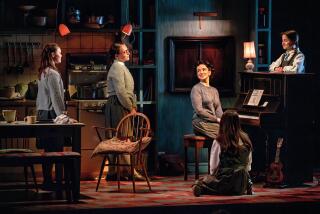THEATER REVIEW ‘A DOLL’S HOUSE’ : On the Home Front : The play from the late 19th Century about marriage and women’s status is still relevant today.
- Share via
Torvald Helmer is a banker whose career is about to rise another notch or two. His wife, Nora, adores him, and the affection is returned. Torvald’s respect for Nora, though, is less than total--he refers to her as his “little squirrel.”
She might as well be Barbie, living in a dollhouse. And while Barbie didn’t exist in Norway in 1879, women’s domination by their husbands was familiar enough to prompt Henrik Ibsen to write “A Doll’s House.”
Nora’s misguided attempt to aid her ailing husband results in a crisis affecting the Helmers’ marriage, much like the iceberg affected the Titanic. What happens next was pretty strong stuff at the time and is still relevant a century later as women continue to seek social equality.
The play is being presented in English- and Spanish-language versions by the Santa Paula Theater Center.
Life in Christiania (today’s Oslo) at the time was more slowly paced than in today’s Southern California, and “A Doll’s House” develops rather slowly over three acts in as many hours.
Which is not to say that the play is static; there’s always something going on--an irate and vengeful former employee of Helmer’s happens by, as does (most conveniently, after 10 years’ absence) Frau Linde, an old friend of Nora’s who arrives just in time to generate several minutes’ worth of exposition. And why is that doctor always hanging around the Helmer household?
In the English-language version, directed by Frank Dwyer, Robin Keese stars as a spirited Nora who makes a convincing transition as the show approaches its resolution. Gary Best is properly stiff as Helmer, and wins an extra point or so for being able to articulate a phrase like “the indefatigable feminine mind” without tripping over Allen Fletcher’s modern-English script.
Helmer isn’t all bad, we’re given to understand. He failed as an attorney, Nora tells us, because “he wouldn’t take cases that weren’t completely respectable and aboveboard.”
Jill Macy plays Frau Linde, the old friend with convenient timing; Justin Douglas is the somewhat mysterious physician and Ron Rezak is Krogstad, a man with a secret that threatens to topple the Helmer household.
The stage set, designed by William Orcutt, is unusually sumptuous, even by the Santa Paula group’s generally high standard. Frances Erwin is credited with the costumes--Nora’s party dress is a standout. Terry Brenner-Farrell choreographed Nora’s tarantella.
Next week: Review of Spanish-language version of “A Doll’s House, “Casa de Munecas.”
* WHERE AND WHEN
“A Doll’s House” continues through March 8 at the Santa Paula Theater Center, 125 S. 7th St., in Santa Paula. Performances of the English-language version are Thursdays through Saturdays at 8 p.m. and Sundays at 2:30. The Spanish-language version “Casa de Munecas” stars Marcus Clayton and Pat Casiano and plays Saturday afternoons at 2:30 and Sunday evenings at 7. Tickets to all performances are $12.50; $11 for students and seniors, with group rates available. For reservations or further information, call 525-4645.
More to Read
The biggest entertainment stories
Get our big stories about Hollywood, film, television, music, arts, culture and more right in your inbox as soon as they publish.
You may occasionally receive promotional content from the Los Angeles Times.










